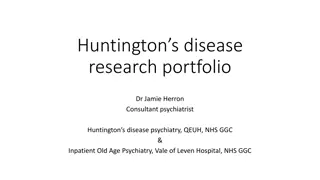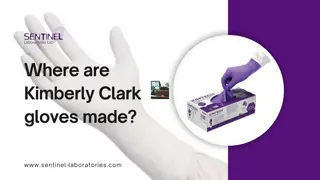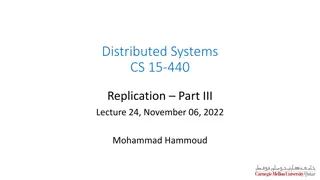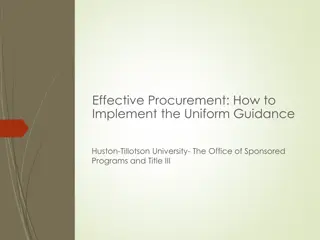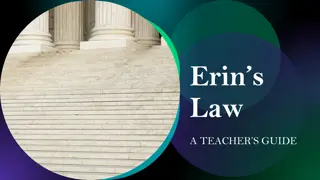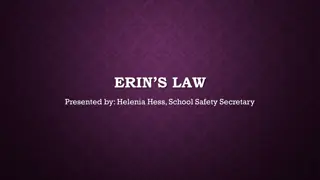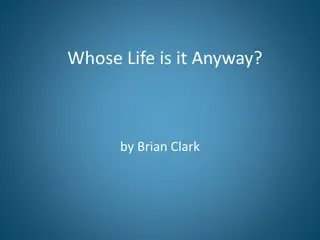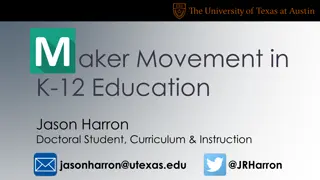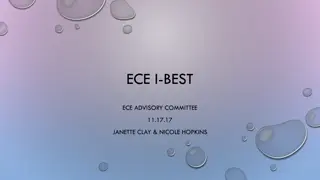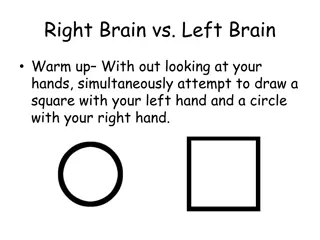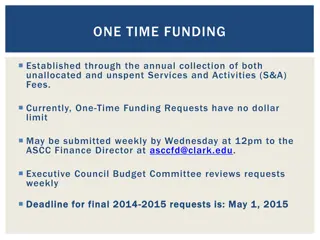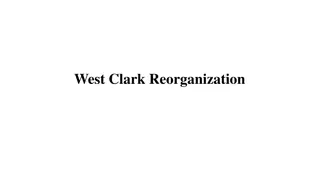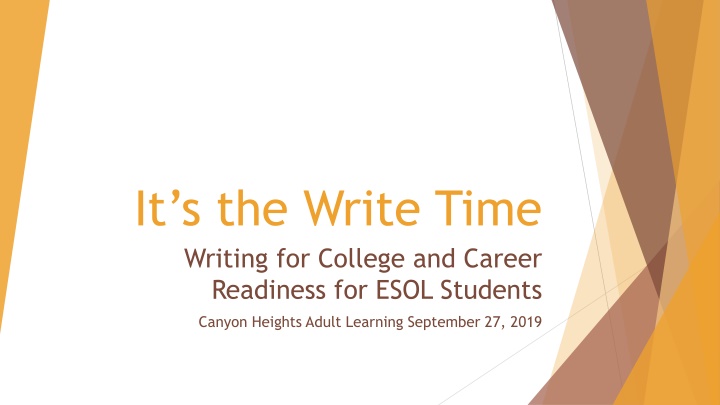
Enhancing Writing Skills for ESOL Students
This program focuses on building a strong foundation in English sentence structure for ESOL students. Starting with basic sentence components, students progress to crafting more complex, compound sentences. Through activities like journaling, peer interviews, and sentence worksheets, students improve their writing skills and gain confidence. The curriculum also covers topics like emails, memos, and recipes to prepare students for real-world writing scenarios.
Download Presentation

Please find below an Image/Link to download the presentation.
The content on the website is provided AS IS for your information and personal use only. It may not be sold, licensed, or shared on other websites without obtaining consent from the author. If you encounter any issues during the download, it is possible that the publisher has removed the file from their server.
You are allowed to download the files provided on this website for personal or commercial use, subject to the condition that they are used lawfully. All files are the property of their respective owners.
The content on the website is provided AS IS for your information and personal use only. It may not be sold, licensed, or shared on other websites without obtaining consent from the author.
E N D
Presentation Transcript
Its the Write Time Writing for College and Career Readiness for ESOL Students Canyon Heights Adult Learning September 27, 2019
Sentences start with a great foundation Students need to know the basics of sentence structure in English to be able to move on to other levels. Is there a verb? Is there a subject? Now let s add more detail Make it more complex
How do you get high beginning students and intermediate students to write? Journal and Share The teacher write a journal topic on the board and shares what their response would be to the journal. Students write what they can in their journal about the topic. The teacher splits them up into groups and they interview each other to ask the journal questions and give a response. This gives some students who couldn t write as much but can speak more a chance to share more about the topic. The students then write something that they learned about each person in their group.
Sentence worksheets Each day the students have a worksheet where they find the different parts of speech and figure out missing punctuation to review what they have been learning. The students learn to see what is missing in their sentences.
Great Writing Foundations This book starts out with the basics so students can also work on sentence and question structure and build up. It gives them the opportunity to explore sentences in context and then the students can apply the writing topics to themselves. It also helps to change from 1stto 3rdperson to practice subject-verb agreement. Board work is very important so that students can see mistakes and learn how to fix them.
Simple Sentences to Compound sentences Students learn to find subject and verb in sentences and then also to use them in their own sentences. Then students move on to adding adjectives and objects to their sentences. Getting students to build their sentences by making them compound or complex. It takes time but gradually the students grasp the concept and build it in their own writing.
Step Forward 3 We take the writing unit of Step Forward 3 and expand it to what they are learning in sentence structure to get them writing about things they may need in life. Students learn about emails, memos, recipes, etc. Students use the new vocabulary and incorporate it into their writing. They do peer reviews and check each others work. Students need to learn these concepts even on a basic level for their current or future jobs.
Next Step: PARAGRAPHS Introduce writing styles* in different language groups. This is the goal: *Initial focus on format of paragraphs, not grammar and spelling. Focusing too early on grammar & spelling can inhibit students.
What is a paragraph? Identify the 6 parts: Indent Topic sentence Sequence words Reasons Examples/explanations Conclusion Introduce the graphic organizer.
I DO, WE DO... I DO: teacher models the first paragraph based on a class reading Students follow the teacher and copy onto the graphic organizer. Teacher models typing the paragraph in Microsoft Word. Indenting, font size 11, double spacing, saving, printing Students then type the paragraph, too, with assistance. WE DO: Second & third paragraph done together as a class, again based on a class reading, with the graphic organizer. From the graphic organizer, students type their paragraphs. Students identify the 6 parts of their paragraphs with highlighters or through peer edit.
NOW, YOU DO! YOU DO: By the 5th paragraph, students use the graphic organizer to create their own paragraphs with teacher support. Teacher assists with the topic sentence. Teacher reviews the graphic organizers to make sure students are on track: AND teacher evaluates examples/explanations. Are they detailed and specific? Give practice on how to do that.
And THEN? Once teacher has assessed that students understand and can use the basic paragraph format Start to review students problem areas with grammar, capitalization, and punctuation. One topic at a time is best. Have students look at their own paragraphs for correction or have students do peer edits on focus areas For example: Check classmate s paragraph for capitalization problems. Remind students that the computer will indicate an error, too. Use student paragraphs, with permission, for whole-class correction practice. 12 Most Common Errors (worksheet): teacher indicates a problem, but students must determine what s wrong. Students continue writing paragraphs Introduce citing sources and different types of paragraphs.
Transition Writing Multi-paragraphs to essays Non-fiction topics Citing text evidence Constructed response Deepening the depth in the DOK Understanding the prompt Peer review
Multi-paragraph format Paragraph one Begin with a summary Claim or Thesis Transition First point Evidence commentary Paragraph two Transition Second Point Evidence Commentary conclusion
Non-fiction Topic What are traits which make Noah extraordinary?
Noah Carver is a teenager who was born blind. He is an extraordinary individual who does not allow his disability to hold him back. Summarize the topic
In the article Nothing Holds Me Back in Scholastic Scope December 2018 by Kristin Lewis, we learn that Noah has positive traits, which prove that he is extraordinary. Cite the article and introduce the claim or thesis statement
Use a transition word or phrase and state the first point One trait is courage.
One trait is courage. Noah shows courage when he runs a 10K over rugged terrain and hilly landscape (5). Use evidence and cite the page number
It is difficult even for sighted people to run over rough ground during a race. For a blind person, like Noah, who cannot anticipate the change in the ground, it takes courage to accept that he might fall and injure himself at any moment. Add commentary to connect the evidence to the point.
Transition to additional evidence and commentary Furthermore, Noah courageously skis, races a boat, fishes for lobster, and rides horses (6). These are all courageous activities for anyone let alone someone who is blind. But Noah also finds it takes courage doing what sighted people would consider to be a simple action like finding someone to sit with at lunch each day. sometimes when Noah walks into the cafeteria, no one calls out to him and invites him to sit down. So instead, he walks up and down the aisles listening for a familiar voice and then asks if he can join the group (7) Clearly, his being on display and hoping to find a group to join is unnerving at best calling on his courage daily.
Paragraph Two: use a transition and introduce the second point Another of Noah s positive traits is a deep determination.
Use evidence and commentary for the second point.
In the end, we can see that Noah is a courageous and determined young man. He is truly extraordinary. Noah is person I can learn from because he inspires me to work harder at developing myself. I do not think that I will ever forget him. Conclude and tie the claim, evidence, and commentary together
Essay Writing Non-fiction Topic How has dental care changed over the centuries? What challenges do we still face today?
Introduction Essay Writing Format Body paragraphs conclusion
Essay introduction Hook Topic Summary Thesis statement or claim
Get the readers attention with a question, observation, surprising statistic, or interesting quote Hook How do you feel about dental care? Do you struggle to go to dentist thinking about pain? Or do you just go because it is necessary? I do.
Topic summary: Briefly help reader understand the topic. Cite the article Going to the dentist is certainly not a pleasing thing to do, but it is not a life and death situation. In fact, according to the History of Teeth and Where Are All the Dentists by Kristin Lewis in October 2017 Scholastic Scope, if we compared people s experience with dental care from ancient history, someone could make the case that our dentist experience is quite pleasing.
Compared with old times, dental care has improved significantly in many ways. However, we still face a few challenges. Thesis statement or claim
How do you feel about dental care? Do you struggle to go to dentist thinking about pain? Or do you just go because it is necessary? I do. Going to the dentist is certainly not a pleasing thing to do, but it is not a life and death situation. In fact, according to the History of Teeth and Where Are All the Dentist by Kristin Lewis in October 2017 Scholastic Scope, if we compared people s experience with dental care from ancient history, as well as not so long ago, someone could make the case that our dentist experience is quite pleasing. Compared with old times, dental care has improved significantly in many ways. However, we still face a few challenges.
Transition and first point: Body Paragraph Format How people dealt with tooth pain is one great contrast.
Evidence and commentary both historical and current In the past, to deal with tooth pain meant to drink a few gulps of whisky to dull the searing pain and have your tooth yanked out with pliers by a barber (14). Today however, we lay down on a comfortable chair, sometimes watching shows from a TV placed on the ceiling and dosed up with anesthetic and feel nothing during the treatment. Treatment today, does not necessarily means to have your tooth removed. Today s technology, tools, and certified dentists are capable of cleaning, restructuring and literally saving various teeth from illness and bad conditions. Body Paragraph Format continued
Concluding transition word or phrase Use an element from the introduction Summarize the thesis Concluding sentence(s) prediction, advise, opinion or observation Conclusion format
To conclude, even though most people hate going to the dentist, it is much better now than it has ever been. We suffer far less, and few people experience any danger in a dentist s office. We do need to bring this good care to more people and make it more affordable. I believe that the government can lead the way for this by providing socialized dental care for everyone.
Understanding the prompt Make sure all parts of the prompt are answered: Describe the author s tone in the section How to solve the Dental Problems. What words and phrases help create this tone? How much and in what ways would a person have to change before they are someone else? How does Margie feel about being called little lady ? How can you tell?
Peer Review Do the following for each essay in your group: 1. Title each paragraph Introduction, point one, point two, point three, conclusion 2. Is each paragraph indented? Introduction 1. Highlight hook 2. With a different color highlight thesis statement. 3. Are the hook and the thesis statement smoothly connected?
Thanks for participating Our information: Jamie Mathews jmathews@dsdmail.net Erin Clark eclark@dsdmail.net Darece Sperry dsperry@dsdmail.net

